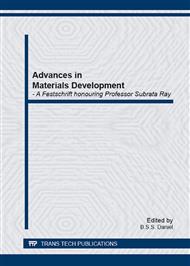[1]
A. J. Heeger, Semiconducting and metallic polymers: the fourth generation of polymeric materials, Nobel Lecture, (2000) 380-417.
Google Scholar
[2]
A. G. MacDiarmid, Nobel Lecture (2000) 427-447.
Google Scholar
[3]
M. Pope, H. P. Kallmann and P. Magnante, Electroluminescence in organic crystals, J. Chem. Phys., 38, (1963) 2042-(2043).
DOI: 10.1063/1.1733929
Google Scholar
[4]
C. W. Tang, S. A. VanSlyke, Organic electroluminescent diodes, Appl. Phys. Lett., 51, (1987) 913-915.
DOI: 10.1063/1.98799
Google Scholar
[5]
C. W. Tang, S. A. VanSlyke, Electroluminescence of doped organic thin films, J. Appl. Phys., 65, (1989) 3610-3616.
DOI: 10.1063/1.343409
Google Scholar
[6]
M. A. Baldo, D. F. O'Brien, Y. You, A. Shoustikov, S. Sibley, M. E. Thompson and S. R. Forrest, Highly efficient phosphorescent emission from organic electroluminescent devices, Nature, 395, (1998) 151-154.
DOI: 10.1038/25954
Google Scholar
[7]
M. A. Baldo, The electronic and optical properties of amorphous organic semiconductors, Ph. D. dissertation, Princeton University, (2001).
Google Scholar
[8]
J. H. Burroughes, D. D. C. Bradley, A. R. Brown, R. N. Marks, K. Mackay, R. H. Friend, P. L. Burns and A. B. Holmes, Light emitting diodes based on conjugated polymers, Nature, 347, (1990) 539-541.
DOI: 10.1038/347539a0
Google Scholar
[9]
A. Sharma, M. Katiyar, Deepak, S. Shukla and S. Seki, Effect of ambient, excitation intensity and wavelength, and chemical structure on photodegradation in polysilanes, J. Applied physics 102, (2007) 104902.
DOI: 10.1063/1.2809422
Google Scholar
[10]
A. Sharma, M. Katiyar, Deepak and S. Seki, Polysilane based organic light emitting diodes: simultaneous ultraviolet and visible emission, J. Appl. Phys., 102, (2007) 084506.
DOI: 10.1063/1.2800173
Google Scholar
[11]
A. Sharma, M. Katiyar, Deepak, S. Seki and S. Tagawa, Room temperature ultraviolet emission at 357 nm from polysilane based organic light emitting diode, Appl. Phys. Lett., 88 (2006) 143511-143513.
DOI: 10.1063/1.2193652
Google Scholar
[12]
A. Sharma, U. Lourderaj, Deepak and N. Satyamurthy, Determination of stability and degradation in polysilanes by an electronic mechanism, J. Phys. Chem. B, 109, (2005) 15860-15867.
DOI: 10.1021/jp0508756
Google Scholar
[13]
Deepak, Development of passive matrix full color organic light emitting diode display, Proc. of IWPSD, (2007) 528-532. (available on IEEEexplore).
DOI: 10.1109/iwpsd.2007.4472566
Google Scholar
[14]
Dipti Gupta, Effect of pentacene thickness in organic thin film transistors: measurements and simulations in top and bottom contact devices, Ph.D. Dissertation, IIT Kanpur (2007).
Google Scholar


